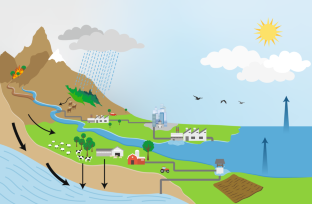Climate change can trigger a sequence of events of significant magnitude with consequences for waterborne diseases. Heavy rainfall, flooding and hot weather are associated with waterborne diseases, but early warning systems could intercept these cascading risks.
This is a preview of subscription content, access via your institution
Relevant articles
Open Access articles citing this article.
-
Climate Change and Cascading Risks from Infectious Disease
Infectious Diseases and Therapy Open Access 19 May 2022
Access options
Access Nature and 54 other Nature Portfolio journals
Get Nature+, our best-value online-access subscription
$29.99 / 30 days
cancel any time
Subscribe to this journal
Receive 12 print issues and online access
$209.00 per year
only $17.42 per issue
Buy this article
- Purchase on Springer Link
- Instant access to full article PDF
Prices may be subject to local taxes which are calculated during checkout


References
Semenza, J. C. et al. Transbound. Emerg. Dis. 66, 1855–1863 (2019).
Semenza, J. C. & Menne, B. Lancet Infect. Dis. 9, 365–375 (2009).
IPCC. Special Report on Global Warming of 1.5 °C (eds Masson-Delmotte, V. P. et al.) (WMO, 2018).
Suk, J. E., Vaughan, E. C., Cook, R. G. & Semenza, J. C. Eur. J. Public Health https://doi.org/10.1093/eurpub/ckz111 (2019).
Guzman Herrador, B. R. et al. Environ. Health 14, 29 (2015).
Levy, K., Woster, A. P., Goldstein, R. S. & Carlton, E. J. Environ. Sci. Technol. 50, 4905–4922 (2016).
Lo Iacono, G. et al. PLoS Negl. Trop. Dis. 11, e0005659 (2017).
Semenza, J. C. et al. Crit. Rev. Environ. Sci. Technol. 42, 857–890 (2012).
Curriero, F. C., Patz, J. A., Rose, J. B. & Lele, S. Am. J. Public Health 91, 1194–1199 (2001).
Guzman Herrador, B. R. et al. J. Water Health 14, 1019–1027 (2016).
Thomas, K. M. et al. Int. J. Environ. Health Res. 16, 167–180 (2006).
Nichols, G., Lane, C., Asgari, N., Verlander, N. Q. & Charlett, A. J. Water Health 7, 1–8 (2009).
Semenza, J. C. & Nichols, G. Euro Surveill. 12, E13-4 (2007).
Sterk, A., Schijven, J., de Roda Husman, A. M. & de Nijs, T. Water Res. 95, 90–102 (2016).
Adkins, H. J. et al. J. Clin. Microbiol. 25, 1143–1147 (1987).
Dewan, A. M., Corner, R., Hashizume, M. & Ongee, E. T. PLoS Negl. Trop. Dis. 7, e1998 (2013).
Desai, S. et al. Clin. Infect. Dis. 48, 691–697 (2009).
Kelley, C. P., Mohtadi, S., Cane, M. A., Seager, R. & Kushnir, Y. Proc. Natl Acad. Sci. USA 112, 3241–3246 (2015).
Singh, R. B. et al. Environ. Health Perspect. 109, 155–159 (2001).
Effler, E. et al. Emerg. Infect. Dis. 7, 812–819 (2001).
Schijven, J. et al. Risk Anal. 33, 2154–2167 (2013).
Shapiro, R. S. & Cowen, L. E. MBio 3, e00238–12 (2012).
Cherrie, M. P. C. et al. BMC Public Health 18, 1067 (2018).
Lake, I. R. Environ. Health 16(Suppl. 1), 117 (2017).
Yun, J. et al. Sci. Rep. 6, 28442 (2016).
Hume, R., Berndt, K. D., Normark, S. J. & Rhen, M. Cell 90, 55–64 (1997).
Djennad, A. et al. BMC Infect. Dis. 19, 255 (2019).
Lake, I. R. et al. Euro Surveill. 24, 180028 (2019).
Baker-Austin, C. et al. Emerg. Infect. Dis. 22, 1216–1220 (2016).
Semenza, J. C. et al. Environ. Health Perspect. 125, 107004 (2017).
Damania, R. et al. Uncharted Waters : The New Economics of Water Scarcity and Variability (World Bank, 2017).
European Centre for Disease Prevention and Control. Vibrio map viewer. E3 Geoportal https://e3geoportal.ecdc.europa.eu/SitePages/Vibrio%20Map%20Viewer.aspx (2020).
Acknowledgements
I would like to thank J. Takkinen and M. Catchpole at the European Centre for Disease Prevention and Control for critical feedback on the manuscript. The views and opinions expressed herein are the author’s own and do not necessarily state or reflect those of the ECDC. The ECDC is not responsible for the data and information collation and analysis and cannot be held liable for conclusions or opinions drawn.
Author information
Authors and Affiliations
Corresponding author
Ethics declarations
Competing interests
The author declares no competing interests.
Rights and permissions
About this article
Cite this article
Semenza, J.C. Cascading risks of waterborne diseases from climate change. Nat Immunol 21, 484–487 (2020). https://doi.org/10.1038/s41590-020-0631-7
Published:
Issue Date:
DOI: https://doi.org/10.1038/s41590-020-0631-7
This article is cited by
-
Modeling flood susceptibility zones using hybrid machine learning models of an agricultural dominant landscape of India
Environmental Science and Pollution Research (2023)
-
Modified effects of air pollutants on the relationship between temperature variability and hand, foot, and mouth disease in Zibo City, China
Environmental Science and Pollution Research (2022)
-
Climate Change and Cascading Risks from Infectious Disease
Infectious Diseases and Therapy (2022)
